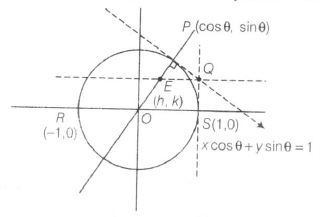Answer:
Option A,C
Explanation:
Given, RS is the diameter of $x^{2}+y^{2}=1$,
Here , equation of the tangent at $P(\cos\theta,\sin\theta)$ is $x\cos\theta+y\sin\theta=1$

Intersecting with x=1
$y=\frac{1-\cos\theta}{\sin \theta}$
$\therefore$ $Q\left(1.\frac{1-\cos\theta}{\sin\theta}\right)$
$\therefore$ Equation of the line through Q parallel to RS is
$y=\frac{1-\cos \theta}{\sin\theta}=\frac{2\sin^{2}\frac{\theta}{2}}{2\sin\frac{\theta}{2}\cos\frac{\theta}{2}}=\tan\frac{\theta}{2}$ ............( i)
Normal at $P:y=\frac{\sin\theta}{\cos\theta}.x$
$\Rightarrow$ $y=x\tan\theta$ ...........(ii)
Let their point of intersection be (h,k),
Then, $k=\tan\frac{\theta}{2}$ and $k=h\tan\theta$
$\therefore$ $k=h\left(\frac{2\tan\frac{\theta}{2}}{1-\tan^{2}\frac{\theta}{2}}\right)$
$\Rightarrow$ $k=\frac{2h.k}{1-k^{2}}$
$\Rightarrow$ $k(1-k^{2})=2hk$
$\therefore$ Locus for point $E:2x=(1-y^{2})$ .....(iii)
when $x=\frac{1}{3}$
then $1-y^{2}=\frac{2}{3}$
$\Rightarrow$ $y^{2}=1-\frac{2}{3}$
$\Rightarrow$ $y=\pm\frac{1}{\sqrt{3}}$
$\therefore \left(\frac{1}{3},\pm\frac{1}{\sqrt{3}}\right)$ satisfy $2x=1-y^{2}$
when $x=\frac{1}{4},$ then
$1-y^{2}=\frac{2}{4}$
$\Rightarrow$ $y^{2}=1-\frac{1}{2}$
$\Rightarrow$ $y=\pm\frac{1}{\sqrt{2}}$
$\therefore\left(\frac{1}{4},\pm\frac{1}{2}\right)$ does not satisfy $1-y^{2}=2x$